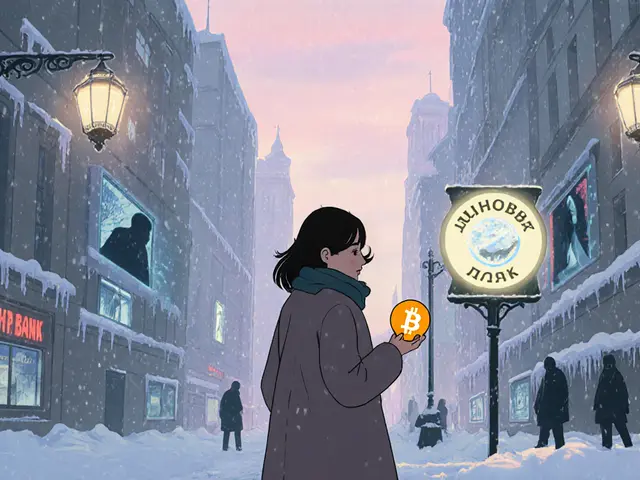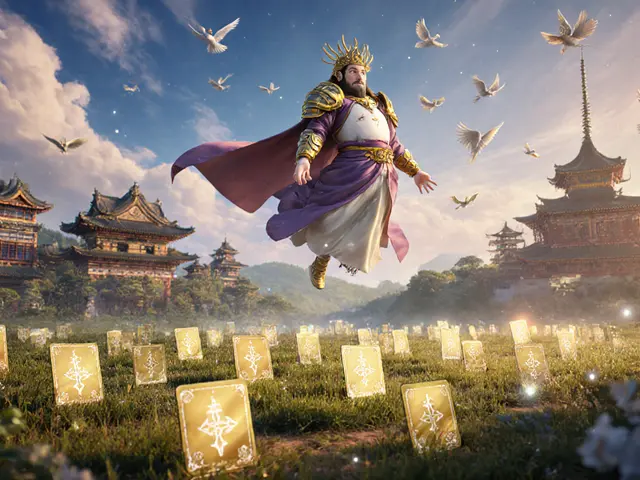14
What is WINkLink (WIN) crypto coin? A clear guide to its purpose, price, and role in TRON

WINkLink Staking Calculator
Staking Calculator
Calculate potential rewards from staking WIN tokens based on current APY rates
Estimated Staking Results
Based on current APY: 10%
WINkLink is built for TRON blockchain utility
Estimated Rewards: 0 WIN
Total After Staking: 0 WIN
WINkLink isn’t just another crypto coin. It’s the engine behind one of the few specialized oracle networks built exclusively for the TRON blockchain. If you’ve ever wondered how a blockchain knows the result of a football match, the price of gold, or who won a digital dice game, WINkLink is likely the reason. It connects real-world data to smart contracts on TRON - and that’s its entire reason for existing.
What problem does WINkLink solve?
Blockchains like TRON are isolated systems. They can’t reach out and grab live data from the internet on their own. That’s a problem for apps that need real-time information - like a betting platform that needs to know if Team A won, or a loan system that needs to check the price of ETH. Without external data, these apps can’t work. WINkLink fixes that. It’s an oracle - a trusted middleman that fetches off-chain data and feeds it securely onto the TRON blockchain. Think of it like a courier who picks up a weather report from a meteorological service and delivers it to a smart contract that automatically pays out insurance claims if it rains. WINkLink makes sure that data is accurate, tamper-proof, and delivered on time. Unlike Chainlink, which works across Ethereum, Solana, and others, WINkLink is laser-focused on TRON. That means it’s deeply integrated with TRON’s ecosystem. It’s not trying to be everything to everyone. It’s built to be the best oracle for TRON-based games, DeFi apps, and prediction markets.How does WINkLink work?
WINkLink runs on a network of independent nodes - computers run by individuals or groups who stake WIN tokens to participate. These nodes collect data from multiple sources: APIs, sports databases, financial feeds, gaming platforms. They cross-check the information, vote on its accuracy, and then submit it to the TRON blockchain. The system is designed to be unpredictable and resistant to manipulation. No single node controls the outcome. If one node tries to lie, the others can reject it. Honest participants are rewarded with WIN tokens. Dishonest ones lose their stake. It’s a simple incentive structure that keeps the network honest. The WIN token itself is a TRC20 token - the same standard used by all native tokens on TRON. That means it’s fast, cheap to transfer, and compatible with every TRON wallet and dApp. You won’t find WIN on Ethereum or BSC. It lives and breathes on TRON.What can you do with WIN tokens?
WIN isn’t just a speculative asset. It has real utility inside the ecosystem:- Paying for oracle services: Developers using WINkLink to pull data into their apps must pay a fee in WIN tokens.
- Staking for rewards: Holders can lock up their WIN to become node operators or support the network. In return, they earn more WIN as a reward for helping secure the oracle.
- Governance: Token holders can vote on upgrades, fee structures, and new features. The more WIN you hold, the more weight your vote carries.
- Access to dApps: Some TRON-based games and DeFi platforms require WIN to play or participate.
Current price and market status (as of November 2025)
As of now, WIN trades around $0.00005251. That’s down 98.19% from its all-time high of $0.002894 in 2021. But it’s also up 25.47% from its lowest point of $0.00004185 earlier this year. With a circulating supply of 993.7 billion tokens and a max supply of 999 billion, WIN is extremely abundant. That’s why the price per token is so low - it’s not about scarcity, it’s about utility. The market cap sits at roughly $36 million, which puts it around #610 on the overall crypto list. Despite the low ranking, trading volume stays steady - around $19 million in 24 hours. That’s not Bitcoin-level activity, but for a niche oracle token, it’s healthy. Over the past week, WIN outperformed the broader crypto market, rising 7.3% while the market average rose just 2.1%.
Who uses WINkLink?
The biggest users are TRON-based gaming platforms. Think decentralized casinos, dice games, sports betting apps, and NFT-based games that need random, verifiable outcomes. WINkLink ensures fairness - no one can rig the results because the data comes from a decentralized oracle, not a central server. DeFi protocols on TRON also rely on WIN. Lending platforms use it to get real-time asset prices. Insurance dApps use it to trigger payouts based on weather or flight delays. Prediction markets use it to settle bets on elections or crypto prices. It’s not used by big enterprises. You won’t see WINkLink powering Wall Street trading bots or global supply chains. That’s not its job. Its job is to serve the TRON community - and in that space, it’s one of the most important tools.How does it compare to Chainlink?
Chainlink is the giant. It’s on Ethereum, Solana, Polygon, BSC, and more. It’s trusted by banks, governments, and Fortune 500 companies. It’s the Swiss Army knife of oracles. WINkLink is the pocket knife. It’s smaller, focused, and only works on TRON. But on TRON, it’s often the only game in town. Because it’s built from the ground up for TRON’s architecture, it’s faster and cheaper to integrate than trying to port Chainlink over. If you’re building on TRON, WINkLink is your natural choice. If you’re building on Ethereum, Chainlink is your only real option. They’re not direct competitors - they serve different ecosystems.Is WINkLink a good investment?
That depends on what you’re looking for. If you want a crypto that will double in value next month - WIN probably isn’t it. Its price history shows extreme volatility and a long, slow decline from its peak. Most of its value is tied to the health of the TRON ecosystem. If TRON grows, WIN grows. If TRON stagnates, WIN will struggle. But if you believe in TRON’s future - especially in gaming and DeFi - then WIN is a core piece of infrastructure. Like owning shares in a water company when a city is expanding, WIN’s value comes from being essential to the system’s function, not from hype. Long-term projections from analysts suggest WIN could reach $0.000102 by the end of 2025, $0.000604 by 2030, and even $0.0728 by 2050. Those are speculative, but they’re based on one assumption: TRON’s ecosystem will keep growing, and WIN will remain its primary oracle.
What’s next for WINkLink?
There’s no official roadmap publicly listed, but the project’s direction is clear: deepen integration with TRON gaming and DeFi apps. Expect more partnerships with decentralized casinos, more dApps using WIN for random number generation, and possibly new staking incentives to boost node participation. The biggest risk? TRON losing relevance. If Ethereum or Solana dominate DeFi and gaming, WINkLink could become irrelevant. But as long as TRON keeps attracting developers and users - especially in Asia, where it’s popular - WIN will have a role.How to get WIN tokens
You can buy WIN on major exchanges that support TRC20 tokens: MEXC, Gate.io, Bitrue, and OKX. Look for the WIN/TRX or WIN/USDT trading pair. Never send WIN to an Ethereum wallet - it won’t work. Use a TRON-compatible wallet like TronLink or Trust Wallet. You can also earn WIN by staking it on platforms that support WINkLink staking. Rewards vary, but they typically range between 5% and 15% APY depending on network conditions.Final thoughts
WINkLink isn’t flashy. It doesn’t have celebrity endorsements or viral memes. But it solves a real, technical problem that’s critical for blockchain apps to function. It’s not a get-rich-quick coin. It’s a utility token - the kind that powers the invisible infrastructure behind the apps you use. If you’re interested in TRON, DeFi, or blockchain gaming, understanding WINkLink isn’t optional. It’s foundational. Whether you’re a developer, a staker, or just a curious observer - this is the backbone of one of crypto’s most underrated ecosystems.Is WINkLink the same as TRON?
No. TRON is the blockchain network - like Ethereum or Solana. WINkLink is a service built on top of TRON that provides real-world data to apps running on it. WIN is the token used to pay for that service. TRON’s native token is TRX. WIN is a separate TRC20 token.
Can I mine WIN tokens?
No, WINkLink doesn’t use mining. Instead, it uses a staking model. You earn WIN by locking up your tokens to help run the oracle network. This is more energy-efficient and aligns incentives with network security.
Why is WIN’s price so low?
WIN has a maximum supply of nearly 1 trillion tokens. That means each individual token is worth very little. Its value isn’t in scarcity - it’s in usage. As more apps on TRON use WINkLink’s oracle services, demand for WIN increases. The low price reflects supply, not lack of utility.
Is WINkLink safe to use?
Yes, as long as you use trusted platforms. The oracle network itself is decentralized and secure, with multiple nodes verifying data. But like all crypto, risks come from exchanges, wallets, or scams. Always use official links, never share your private keys, and double-check contract addresses before sending tokens.
Can I stake WIN to earn passive income?
Yes. Many TRON wallets and platforms allow you to stake WIN. You lock your tokens for a period, help secure the oracle network, and earn rewards in WIN. APY varies based on network demand - typically between 5% and 15%. Check the official WINkLink website or trusted TRON staking platforms for current rates.
What’s the difference between WIN and TRX?
TRX is TRON’s native currency. It’s used to pay for gas fees on the TRON network - like sending transactions or deploying smart contracts. WIN is used specifically for WINkLink oracle services: paying for data, staking, and governance. You need TRX to send WIN, but you need WIN to use WINkLink’s services.








